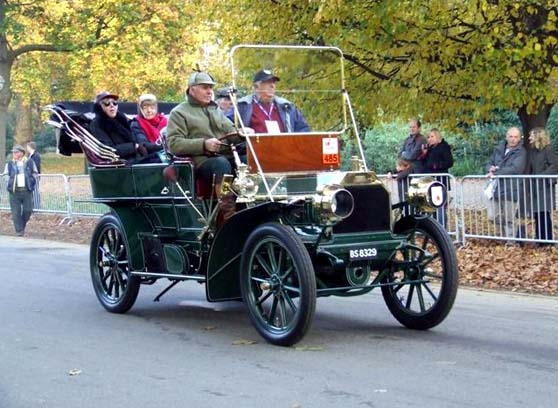
7 June 2010
Early Settlers Came Out to Watch as Napier Travelled the Rails

A 1904 Napier car.

Moose Jaw Saskatchewan - In 1904 the sight of an automobile was wonder enough, but onlookers
must have gasped in astonishment when they saw Charles Glidden's four-ton Napier auto with flanged steel wheels travelling along the railroad track towards
Moose Jaw.
Giddden and his British-built Napier were on the initial lap of the first round-the-world automobile tour ever undertaken, and many of the countries to be
visited would see, for the first time, a horseless carriage.
A wealthy Bostonian, Charles Glidden was one of the best known of the American automobile pioneers. He also oversaw the development of the telephone, having
directed the first successful test of long-distance telephony for Alexander Graham Bell. It was his discovery that women's voices carried better than men's
over wires that led to women becoming telephone operators.
The Napier automobile carrying Mr. and Mrs. Glidden and an English chauffeur, Charles Thomas, travelled from Boston to Minneapolis over conventional roads.
Then at the Shoreham Shops in Minneapolis, the wooden wheels were replaced with flanged steel tires for the trip by rail across the Canadian prairies and
mountain ranges to Vancouver.
The Canadian Pacific Railway insisted that one of its conductors accompany the automobile. The Moose Jaw Times reported: "Conductor E.H. Cooke left
last evening for Portal where he will take charge. The automobile is a 24 horsepower Napier, fitted with 40-inch steel flanged wheels. The trip will be made
under regular train orders from the dispatchers and all rules will be complied with."
At Portal, Glidden logged: "Conductor Cooke handed me a copy of the first train order ever issued in British America for a motor car to run on the
railway tracks." The order was signed by J. Rutherford, dispatcher. (John Rutherford was one of Moose Jaw's first settlers and had been its fifth mayor as
well as councillor and sheriff.)
"At Estevan we were ordered ahead to Weyburn, then to Pasqua, and finally to Moose Jaw. For the first time we were sent ahead of the express with
20-minute leeway... the express failed to overtake us, not withstanding there were many slowdowns on account of work on the road," recorded dispatcher
Rutherford.
Actually Glidden preferred to follow rather than lead a fast express "as the tension is too great keeping out of their way, although as far as speed of
car is concerned, it can be easily done."
Setters who lived along the Soo Line must have fallen out of their buggies at the spectacle. Most had never seen an automobile before so the slight of one
flying along railway tracks at an unheard-of speed, was almost too much for the pioneer mind to grasp. Nevertheless, Glidden recorded that "salutations,
loud cheers, and waving of handkerchiefs greeted us... as we passed by the stations."
The Gliddens arrived at Moose Jaw in the early afternoon of 8 Sep 1904, and gave the town the first known record of the appearance of an automobile in this
district.
On the following morning the Napier left Moose Jaw for the Pacific coast. "We are now on the mainline of a great transcontinental route and came in
contact with an immense amount of traffic, regular and extras," Glidden wrote. "But for the good work of train dispatchers... we should have fallen
far short of intended destinations."
The next overnight stop was made at Maple Creek. "The country passed through today is broad prairie, ranch lands, treeless, and not yet settled although a
house was visible about every 20 miles."
"Not a moment's delay has been caused in the operation of the car since leaving Minneapolis and Conductor Cooke says our speed is at times 10 miles per
hour faster than the Imperial Limited."
The Napier and its passengers were still in fine fettle when it pulled into Calgary. The following day it was on to Banff where the Napier became the first
automobile to invade that mountain resort.
In the next 137 miles, the Gliddens travelled the spectacular rail route over the Rocky and Selkirk mountain ranges. At this time the famous Spiral Tunnels had
not yet been built to ease the descent from the Kicking Horse Pass, which meant the rail line dropped 1,140 feet in seven miles. The Napier took the drop
without the use of brakes, the momentum of the car being checked by cylinder compression.
"Wise railroad men thought it best for us to follow closely a passenger train, which we did within 20 feet, as possibly on a frosty rail our wheels might
skid beyond the usefulness of compression or brakes... Our speed made climbing the mountains dumbfounded the train dispatchers and employees of the
railroad."
At Lake Louise Conductor Edgar Cook left the Gliddens and returned to Moose Jaw where he continued to railroad for many years.

|



